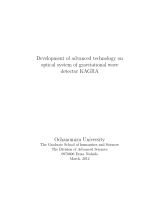Development of advanced technology on optical system of gravitational wave detector KAGRA
この論文にアクセスする
この論文をさがす
著者
書誌事項
- タイトル
-
Development of advanced technology on optical system of gravitational wave detector KAGRA
- 著者名
-
西田, 恵里奈
- 著者別名
-
ニシダ, エリナ
- 学位授与大学
-
お茶の水女子大学
- 取得学位
-
博士 (理学)
- 学位授与番号
-
甲第63号
- 学位授与年月日
-
2012-03-23
注記・抄録
博士論文
application/pdf
学位論文
Gravitational wave is the space-time distortion, which propagates\\r\\\<br/>with a speed of light and its existence is predicted by the theory of\\r\\\<br/>general relativity. It generates from the accelerating super-massive\\r\\\<br/>object. Therefore if gravitational wave were detected, the inner information of black hole binary or neutron star binary merger and of\\r\\\<br/>supernova explosion could be observed, and the information of the\\r\\\<br/>early universe could also abtained. Gravitational wave detection is\\r\\\<br/>expected to open the new astronomy, what is called, gravitational\\r\\\<br/>wave astronomy.\\r\\\<br/>Gravitational wave detection can be performed by the pulsar timing,\\r\\\<br/>the resonant bar and the Michelson laser interferometer, last one of which is developed all over the world the most recently. Tidal space distortion by gravitational wave makes the phase difference between two perpendicularly divided beams, which leads to the interference as fringe. However the displacement by the gravitational wave is only 10-23m/sqrtHz in a liberal estimation. Therefore it is crucial how to eliminate the noise for detection of gravitational wave. The basic noises that determine the sensitivity are seismic noise, quantum noise, thermal noise etc.\\r\\\<br/>Gravitational wave Telescope in Kamioka mine (KAGRA) is the science plan that was approved by Ministry of Education, Culture,Sports, Science and Technology June, 2010 and is the laser interferometric gravitational wave detector, whose arm length is 3km. The aim for KAGRA is first detection of gravitational wave, and thus the creation of gravitational wave astronomy. In this plan, mirrors in interferometer are made cooled to 20K for thermal noise reduction.\\r\\\<br/>Also KAGRA being built in quiet place in Kamioka mine and using suspension system, seismic isolation will be completely achieved.Furthermore KAGRA uses resonant sideband extraction (RSE) as interferometer type for reduction of quantum noise. This configuration is power recycling Michelson interferometer, which used in the 1st generation detector like TAMA300, with signal extraction mirror at detection port. By making the gravitational wave signals from detection port be reinjected or extracted, RSE could make the signal enhanced at particular frequency, and therefore quantum noise is optimized. However RSE has 5 degrees of freedom of arm lengths to be controlled, so that it is so challenging compared with Power \\r\\\<br/>recycling Michelson interferometer (DOF 4).\\r\\\<br/>Laser Interferometer Gravitational wave Observatory (LIGO) in U.S. will use RSE as the second generation detector, Advanced LIGO. Though there are already established methods for the position control, the more challenging method is the initial control, which is to carry the interferometer into a controllable state initially. This is because the finesse is high therefore liner range is too narrow to acquire lock. In advanced LIGO, the way to acquire the lock of RSE is to inject a shorter wave length laser from cavity behind, to lock this cavity by this laser and to shift to main laser. Basically KAGRA will use this method too. However this method\\r\\\<br/>needs the additional instruments, and so it is not yet the established\\r\\\<br/>and trustable method.\\r\\\<br/>Therefore in this research, without any instruments to be added we\\r\\\<br/>develop the original method to make RSE locked software, which never been reached by anyone in the world, and validates its effectiveness by the simulation software. This leads to success to lock the interferometer without any timely or economically loss, even if the lock is failed with the hardware method. Also in near future this software method could be the KAGRA default plan.Initial control is made by the following steps in this system.\\r\\\<br/>1. Making the central part (interferometer composed of Michelson\\r\\\<br/>interferometer, Power recycling mirror and signal extraction\\r\\\<br/>mirror) locked.\\r\\\<br/>2. Making the arm cavity constrained and the central part lock\\r\\\<br/>held.\\r\\\<br/>3.
Making the arm cavity locked by multi-deceleration guided\\r\\\<br/>Lock method.\\r\\\<br/>In central part lock, KAGRA uses the double modulation and double demodulation method. The problem is that after locking central part, central part lock is failed by phase modulation sideband happening to lock in the arm cavity. To avoid this, using the signal that appears when the sideband is on resonance, constrain the arm cavity length and make phase modulation sideband not on resonance in the cavity. By this method, it is possible for central part to hold lock.After central part lock, by multi-deceleration guided Lock method make the arm cavity locked. This is the method to measure the velocity on resonance, according to this value to actuate the force, to repeat several times, to decelerate mirror velocity and to try to acquire lock by usual servo.\\r\\\<br/>To validate this system effectiveness, we use the time domain simulator\\r\\\<br/>for gravitational wave, end to end (e2e), which developed in LIGO. First, make Power recycling mirror, Signal extraction mirror and beam splitter moving then this central part locked by moderate signal. And checked to unlock central part by moving end test mass of cavity. Second, right after the central part locking, constrain the end test mass not to resonate sideband on cavity. We could see its effectiveness and holding lock. Also in the validating of multideceleration guided Lock simulation, there is its effectiveness under larger disturbance at where it cannot control only by servo.\\r\\\<br/>In this way, the effectiveness of main part is approved by simulation.\\r\\\<br/>This could lead to prospect for installation to KAGRA, and would be said that one of task for gravitational wave detection could be achieved.
お茶の水女子大学人間文化創成科学研究科博士(理学)学位論文・平成24年3月23日授与(甲第63号)
